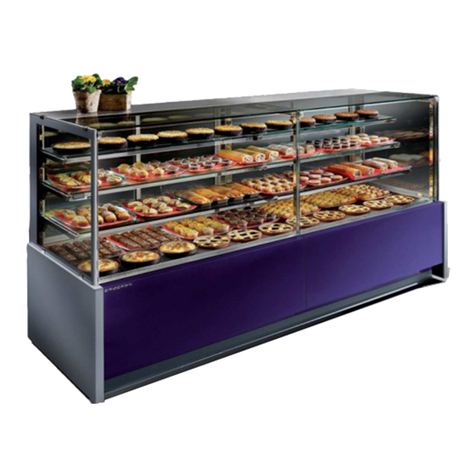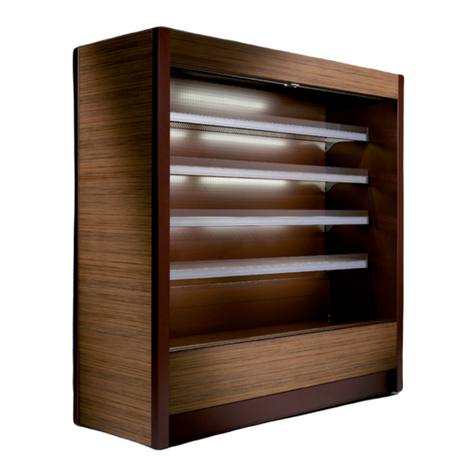CRIOCABIN ESPRIT User manual

INSTRUCTION
MANUAL
ESPRIT


ESPRIT
3
1. Introduction......................................................................................................................................... 5
1.1 Introduction and purpose of the Manual ........................................................................................ 5
1.1.1 Use of this Manual ................................................................................................................... 5
1.2 Warranty conditions ....................................................................................................................... 5
1.3 Graphical conventions .................................................................................................................... 5
1.4 Personnel qualifications ................................................................................................................. 6
1.5 General warnings ........................................................................................................................... 6
1.5.1 To be arranged by the Customer .............................................................................................. 7
1.5.2 Technical assistance ................................................................................................................. 7
1.5.3 Spare parts ................................................................................................................................ 7
2. Information on safety.......................................................................................................................... 8
2.1 General regulations - Training ....................................................................................................... 8
2.2 General regulations - Skills and checks ......................................................................................... 8
2.3 Fire regulations .............................................................................................................................. 8
2.4 First aid regulations ........................................................................................................................ 8
3. Product specification......................................................................................................................... 10
3.1 General description ...................................................................................................................... 10
3.1.1 Structural components. ........................................................................................................... 10
3.1.2 Functional components .......................................................................................................... 10
3.1.3 Control system ....................................................................................................................... 10
3.2 Technical characteristics .............................................................................................................. 11
3.2.1 Dimensions ............................................................................................................................. 11
3.2.2 Lay-out ................................................................................................................................... 12
3.2.3 Weight table ........................................................................................................................... 12
3.2.4 Admissible loads .................................................................................................................... 13
3.2.5 Refrigeration system: ............................................................................................................. 13
3.2.6 Energy consumption ............................................................................................................... 13
3.3 Noise level .................................................................................................................................... 13
3.4 Other emissions ............................................................................................................................ 13
3.5 Environmental requirements for operation .................................................................................. 14
3.6 Description of residual risks ........................................................................................................ 14
3.7 Specific protections ...................................................................................................................... 15
4. Instructions for commissioning ........................................................................................................ 16
4.1 Transport, handling and positioning ............................................................................................ 16
4.1.1 Precautions to be taken upon receipt of the product .............................................................. 16
4.1.2 Handling and positioning ....................................................................................................... 17
4.2 Unpacking and disposal of packaging materials .......................................................................... 18
4.3 Assembly ...................................................................................................................................... 18
4.4 Disassembly and subsequent reassembly ..................................................................................... 26
4.5 Fixing ........................................................................................................................................... 26
4.6 Installation .................................................................................................................................... 26
4.6.1 Connection to a remote condensing unit ................................................................................ 26
4.6.2 Connection to the mains ......................................................................................................... 26
4.6.3 Connection to the drain line ................................................................................................... 27
4.7 Commissioning ............................................................................................................................ 27

ESPRIT
4
4.7.1 Starting: .................................................................................................................................. 27
4.7.2 Setting .................................................................................................................................... 27
4.8 Idle time and restarting ................................................................................................................ 27
5. Instructions for use............................................................................................................................ 28
5.1 Correct use of the cabinet ............................................................................................................. 28
5.2 Uses to be avoided ....................................................................................................................... 28
5.3 Working limits ............................................................................................................................. 29
5.4 Cabinet control functions ............................................................................................................. 29
5.4.1 Manual defrosting .................................................................................................................. 29
6. Maintenance instructions .................................................................................................................. 30
6.1 General warnings ......................................................................................................................... 30
6.2 Periodical cleaning ....................................................................................................................... 30
6.3 Bulb replacing .............................................................................................................................. 31
6.4 Periodical maintenance ................................................................................................................ 31
6.4.1 Check of the glass lifting system ........................................................................................... 31
6.5 Special maintenance ..................................................................................................................... 31
6.6 Troubleshooting ........................................................................................................................... 31
7. Instructions for demolition and disposal........................................................................................... 32
8. Parameter table of control panel ....................................................................................................... 33
8.1 List of parameters ......................................................................................................................... 33
9. Attachments ...................................................................................................................................... 36
9.1 Reference to manuals of other suppliers ...................................................................................... 36
9.2 Declaration of conformity: as attached ........................................................................................ 36
10. Table of figures............................................................................................................................... 37

ESPRIT
5
1. Introduction
1.1 Introduction and purpose of the Manual
Thank you for choosing Criocabin S.p.a., hereinafter referred to as the Manufacturer. We are glad to
have you as our Customer and hope you will be fully satisfied with this product.
This Use and Maintenance Manual is an integral part of the product and is aimed at anyone
who works on the product or interacts with its users.
The purpose of this Manual is to supply the necessary information to enable:
• quick identification of the product parts;
• all the commissioning, functioning and maintenance operations to be carried out on the
product;
• the health and safety of all users and exposed persons to be guaranteed at all stages.
All information, drawings, diagrams, tables and any other contents of this Use and Maintenance Manual
are confidential and therefore the full or partial reproduction or disclosure thereof to third parties is
subject to the authorisation of the Manufacturer in its capacity as sole owner.
1.1.1 Use of this Manual
Read this manual before handling, installing and using the product, and likewise before carrying out
any maintenance work on it.
The term Manufacturer will always be used to indicate Criocabin S.p.a., while the generic term Supplier
will be used to indicate other manufacturers of specific components fitted in the product.
The term Dealer will be used to indicate the company that, according to a distribution agreement
signed with the Manufacturer, is authorised to sell the product and constitutes the Customer’s
commercial counterpart.
Keep this manual away from sources of heat, dampness and corrosive agents throughout the product
working life, pass it on to any other user or subsequent owner and keep it handy for easy reference by
its users.
Handle this manual with care; do not damage it, tear out pages or modify its content for any reason.
The Manufacturer reserves the right to communicate at any moment any information which is
considered necessary for a better and safer use of the product. Such information, provided as
modifications, updating or additions, will have to be considered in all respects as an integral part of this
manual.
1.2 Warranty conditions
Warranty conditions are stated in the sales agreement which is accepted by the Customer by means
of order confirmation.
1.3 Graphical conventions
Bold type is used to highlight information considered important.
References to illustrations are made by means of a number in bold type that identifies the illustration
(i.e. Fig. 1) and, if necessary, by means of a letter or number that identifies the component in question
This manual suits for next models
1
Table of contents
Other CRIOCABIN Commercial Food Equipment manuals
Popular Commercial Food Equipment manuals by other brands

Diamond
Diamond AL1TB/H2-R2 Installation, Operating and Maintenance Instruction

Salva
Salva IVERPAN FC-18 User instructions

Allure
Allure Melanger JR6t Operator's manual

saro
saro FKT 935 operating instructions

Hussmann
Hussmann Rear Roll-in Dairy Installation & operation manual

Cornelius
Cornelius IDC PRO 255 Service manual

Moduline
Moduline HSH E Series Service manual

MINERVA OMEGA
MINERVA OMEGA DERBY 270 operating instructions

Diamond
Diamond OPTIMA 700 Installation, use and maintenance instructions

Diamond
Diamond G9/PLCA4 operating instructions

Cuppone
Cuppone BERNINI BRN 280 Installation

Arneg
Arneg Atlanta Direction for Installation and Use







